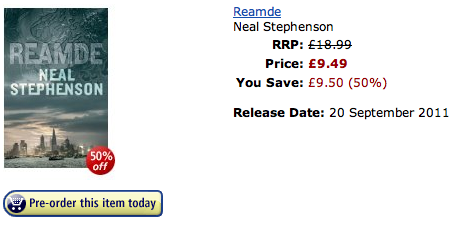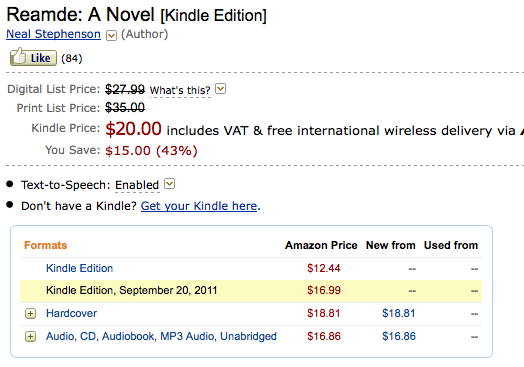Single-Player Auction
Amazon's Experimental Pricing
As I've argued before (in French), there are good reasons for ebooks to actually be sold at higher prices than pbooks. If you reason purely in terms of manufacturing costs, it makes very little sense — but if manufacturing cost influenced much beyond the minimal price that an item may be sold at we would have a very different pricing landscape than the one we know. For starters, the price of Microsoft Office would be hard to evaluate given that, as we all know, each new version is just an increasingly fancy wrapper around the same page-numbering and bullet-indenting bugs that we already paid for fifteen years ago.
The process which produces prices is far more complex than that, but when comparing ebooks and pbooks one thing is clear: ebooks are more convenient (especially in volume and weight), they are more featureful (search, annotation), and if you've already invested in an ebook reader you have an incentive to use it. Overall, this places the value of ebooks higher than that of pbooks, which in turn justifies a comparatively higher price. I certainly know that I, for one, if given a choice, would pay (a little bit) more for an ebook.
One typical problem in pricing strategies is that while it is clear that the seller simply wants to get as much money as possible, different buyers are willing to pay different amounts for the same product. Say for instance that you're selling bacon-flavoured bags of candy. Some people are willing to pay up to €10 for a bag, while others may go as high as €20. If you set your price at €10, you'll get everyone as customers but for every person willing to pay €20 there are €10 that you're not getting. If you raise the price to €15, you get more money from those willing to pay that much, but you're not getting anything from those who consider that too pricey.
A classic approach to this problem is to segment your product. You add a bit of milk to your coffee, call it a latte, and double the price. That way customers get to reveal the price that they're willing to pay by (overall) choosing the product in their price range.
That's all very nice, but what's the link to books (and Amazon)? Hardcovers. Anyone in their right minds hates hardcovers. They're clunky, ugly, huge, and overpriced. But they come out first, and that way customers who are willing to pay that much extra shell out the amount, while those who aren't will likely still buy the book later when it comes out in paperback.
Enter ebooks. You can't pull off the same trick because apart from some fancy
enhancements
which
most sensible readers don't want to even hear of it's hard to differentiate a large blob of text
from
the same large blob of text when you have limited to no control over typography, let alone paper
quality. But it doesn't mean that trying to get each customer to pay as much as she is willing
to
goes away — quite the contrary, it's an opportunity for innovation.
Which in turn brings us to Amazon. It's quite the innovation hot house, even if less flashy than its direct competitors that are Apple or Google. It isn't foreign to innovating with pricing strategies, either. One thing that they've done in the past (I don't know if they still do) is to use dynamic pricing: depending on your spending habits, on your buying patterns, on how much of a loyal customer you are, prices of identical products would be different for different customers (and loyalty meant higher prices since you needn't be hooked).
I've therefore long suspected that they would be trying some interesting pricing tricks with ebooks since they are freed from the shackles of having only hardcover/paperback to differentiate. One simple strategy would be simply to start the price high when the book comes out (or in pre-order) and let it decay to more reasonable levels over time, in small decrements. That way people buy the book when it reaches their price-point. Of course you have to be careful in that people who declined to buy a book because it was too expensive may never return, but if they were identified customers (which if they have a Kindle, they're highly likely to be) you can simply shoot off an email to them some months later when the price has dropped to a level that you think they might accept.
Obviously, since I'm just a guy figuring this out with a bit of popsci culture, I've long equally suspected that the actual model that Amazon's mathematicians would come up with would be much more interesting than that.
I had, however, simply no idea just how interesting.
First thing this morning, I got the following offer from Amazon UK:

£9.49 is about $15, or €10.80. Since I loved Stephenson's previous book,
Anathem
, I really want to
read this one, to the point of pre-ordering it. I hit the link to Amazon.co.uk, but since I got
my
Kindle from Amazon.com the former refuses to sell anything to me (you'd think that by now their
mythical
CRM engine would have sorted that sort of thing out). And here is the screen I was presented
with there
when I looked for Reamde
there:

So the big fat red Kindle price in the top details lists it at $20. But if you look in the list of formats, the yellow-highlighted line which is to say the line corresponding to the item currently being displayed has it at $16.99. It does not show on the picture, but if you hover over that line, it shows the book again, at $20. If you now look at the line above that one, you will see that there is another Kindle edition asking $12.44. Given that this is pre-order and that the more expensive one is labeled "September 20, 2011" I thought that it might be the price for the same book delivered at a later date but no: its release is also planned for September 20, 2011.
This left me quite baffled. Not baffled enough that I didn't get the cheaper one though.
A lot of people will think that this is a bug. It certainly seems too clumsy to be entirely deliberate. But then again, people are used to seeing search results that bring up the same product at different prices, including inside of Amazon since it fronts for many retailers. Those who notice the quirk get the better deal, those who don't are likely never to know. And if anyone complains, it's plausibly deniable as a bug. I'm not claiming that it's intentional, but it does at the very least seem like the consequence of an intentional approach to pricing.
Is it working? The thing is: it really is. As of this writing, the $12.44 version was ranking #949 in the Kindle store. The heisenpriced $16.99/$20 version (which comes first in search results)? Rank #185.
That's one sweet money-making quirk. If it's a bug, I'm killing my debugger right this second.